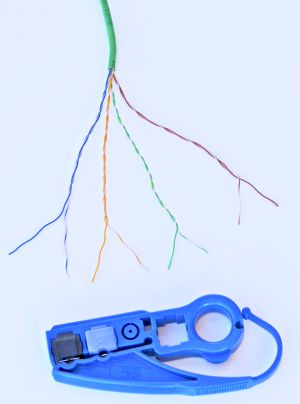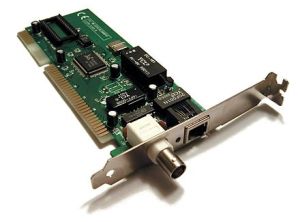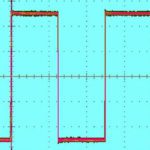Cat 5e (enhanced) and 6a (augmented) are the most frequently-used media in residential and commercial Ethernet networks. Cat 6a has higher bandwidth and is faster, but the less expensive Cat 5e is often chosen when adequate for the application. It performs well up to 100 MHz.
In contrast to coaxial cable, used in the first Ethernet installations, Cat 5e and 6a conductors are not surrounded by an outer metal shield grounded at both ends by connectors contacting the respective chassis. Such bonding is highly effective in controlling electromagnetic interference, but Cat 5e and Cat 6a cable realize comparable protection by means of twisted conductor pairs. Accordingly, these cable types are described as unshielded twisted pairs (UTP).

Twisting a pair of conductors in the same circuit reduces the harmful effects of electromagnetic interference (EMI) due to proximity to one or more conductors carrying oscillating current or to a localized source of noise such as arcing brushes in a universal, dc or synchronous motor. Without balanced differential transmission a pair of wires passing through the oscillating field or noisy electromagnetic environment function as separate monopole antennae. The resulting current flowing through them interferes with the intended analog or digital signal. Even with balanced differential signaling, if the conductors are not twisted, the instantaneous interfering current in one conductor is stronger than in the other because most of the time they are not equidistant from the offending source. Accordingly, for this EMI suppression technique, all of the following are required: balanced transmission, differential signaling and twisted conductors.
In pairs that are twisted, provided that the twist rate or pitch is greater than the wavelength of the interfering signal, the instantaneous signal in each of the conductors is still substantially equal.
When balanced differential signaling is implemented, at the transmitting end signals of equal amplitude (balanced) and opposite polarity (differential) are sent. At the receiving end the difference only between the signals carried by the conductors is amplified. Any common-mode voltage is rejected.
When a cable contains a small number of pairs having the same twist rate, common-mode rejection is less effective because the conductors do not twist relative to one another. To mitigate this effect, adjacent pairs are manufactured with slightly different twist rates. When terminating twisted pairs, the untwisted ends should be as short as possible so the twist rate is maintained.
The first telephone systems used existing telegraph lines. Single-wire circuits were built, the earth serving as the ground return. Soon, parallel two-wire circuits became the norm. In these long lines, series inductance and parallel capacitance became serious problems, as well as electromagnetic interference from outside sources. In aerial transmission lines, electrical power conductors, becoming more prevalent in the late 1800s, shared the same poles. Wires, situated some distance apart on cross ties, were periodically reversed. In cities, this reduced electrical noise induced by electric trams, with arcing dc motors.
Wire transposition in early telephone lines eventually evolved into twisted conductors in the digital age. Twist rates increased to keep up with higher frequencies needed for greater bandwidths.
The greatest single difference between Cat 5e and Cat 6a cable is higher twist rate in 6a, which accounts for its greater bandwidth.
ANSI/TIA-568-A is the document that specifies Cat 5 construction and performance standards. The cable is terminated in either of two schemes, T568A or T568B. It is far more economical to first run the cable and then terminate it in the field. For connecting computers to hubs, routers, modems or the like, the straight-through configuration is used – the same scheme is at both ends. To connect two computers or other similar devices, cross-over cables are used – A scheme at one end and B scheme at the other end. This is so the transmit pin connects to the receive pin at each end. If a hub is connected to a computer, the reversal is made internally, so straight-through configuration is used. That being said, many devices currently manufactured automatically adjust the termination schemes as needed.

Both of these cable types are available in stranded and solid versions. Stranded conductor cable can be bent many times without wear. Consequently, it is suitable for patch cords. Solid conductor cable is intended to be bent only during the initial installation. Different types of RJ-45 (8P8C) connectors are used for stranded and solid.
Cat 5e has replaced the original Cat 5 and similarly, Cat 6a has replaced Cat 6. The earlier cables met the new specifications in terms of bandwidth, but they are no longer certified. The improved cables, however, are said to limit harmful crosstalk.
Cat 5e is certified to 100 MHz and is compatible with 10BASE-T, 100BASE-TX (Fast Ethernet) and 1000BASE-T (Gigabit Ethernet). In 10BASE-T and 100BASE-TX, only two pairs of conductors are required, but normally all four pairs are hooked up for mechanical strength. 1000BASE-T requires four pairs. Actually, the number of pairs in a cable is not specified. Numerous pairs, up to 100, are used in backbone applications.
Specialized UTP cables are available for outdoor use and direct burial, without conduit. However, conduit is common to facilitate replacement.
A useful feature is power-over-Ethernet (PoE). It is convenient for motorized security cameras that pan the scene, and wherever ac power is not in place. A point to note is new PoE specs allow these cables to handle 100-W loads, effectively making them power cables. There have been issues with inexpensively made PoE cables heating and melting at these levels because of poor construction.
Cat 5e is often used for interior telephone zone wiring even though audio does not require the full bandwidth. The cable is inexpensive and its round profile facilitates fishing behind finished surfaces. The extra pairs are good for multiple telephone lines and as spares in case an existing wire is damaged.
Cat 5e has 100-Ω characteristic impedance. The dc loop resistance is 0.188 Ω/m. The capacitance at 800 Hz is 52 pF/m. The inductance is 525 nH/m. Maximum current per conductor is .577 amp. Maximum operating voltage is 125, well in excess of the 57 Vdc needed for PoE.
The minimum bending radius for Cat 5e is four times the outside diameter of the cable, so installers should not crease it when, say, wrapping it around a framing member.
The maximum cable length is 100 m. This figure can be multiplied by interposing active switches or equivalents between segments, but each device requires ac or battery power.
In non-utility U.S. installations, the National Electrical Code has jurisdiction. It is important to observe riser and plenum requirements, which relate to smoke generation and flame propagation.
Cat 6a is backward compatible with Cat 5e cable. It has more stringent noise and crosstalk specifications and higher bandwidth, 500 MHz as opposed to 100 MHz. Modular connectors, 8P8C, and pin assignments, T568A and T568B, are the same. To meet performance specifications, Cat 6a patch cords, jacks and connectors are required.
Ethernet originally used coaxial cable as media, but that has been eclipsed by the widely used and user-friendly UTP and fiber-optic cable in conjunction with switches.

A great advantage of 5e and 6a UTP cable is its comparatively small diameter and modest bending radius, which permits the use of compatible network interfaces in computers and similar devices. Ethernet interfaces are now almost universally connected inside the enclosures of PC motherboards, obviating the need for separate network cards.
A major advance in twisted-pair technology was full-duplex Ethernet. In this mode, both devices can transmit and receive simultaneously, and collision is no longer an issue. The bandwidth of the link is in effect doubled.
Switched Ethernet is more secure than the older shared-medium technology. Nevertheless, it is vulnerable to hackers who know how to do Arp spoofing and MAC flooding. These intruders eventually figure out how to exploit Ethernet vulnerabilities by compelling switches and hosts to send data to unintended destinations. The whole thing is an intricate cat-and-mouse game, where the trespassers seek openings and the defenders plug them with new fixes.





Leave a Reply
You must be logged in to post a comment.